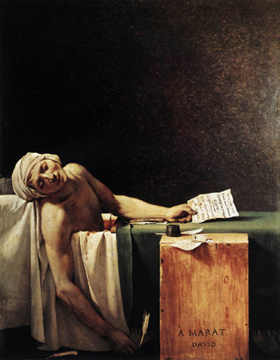
Jacques-Louis David, "The Death of Marat," 1793 (Royal Museum of Fine Arts, Brussels)
On February 7th I drove to the Kasser Theater at Montclair State University to see a performance of The Investigation, a 1966 documentary drama by Peter Weiss (1916-1982), the expatriate German artist and writer best known for Marat/Sade.
This 80-minute version by the theater group Urwintore was conceived and directed by Dorcy Rugamba and Isabelle Gyselinx from an adaption by Jean Baudrillard (the original German production—culled verbatim from the Frankfurt Auschwitz trials of 1963-65—ran nearly five hours).
Urwintore is from Rwanda, and Dorcy Rugamba’s parents and six of his siblings were shot to death by Hutu militiamen on the first day of the Rwandan genocide.
This production is not Rugamba’s first examination of mass murder. In 1999, he co-authored and performed in Rwanda 94, described by Jon Henley of The Guardian as “an extraordinary, emotionally exhausting six-hour creation about his country’s 100 days of madness.” For Rugamba, the four years he spent touring with the work “’rebuilt me.’” In 2004, the play was brought to Rwanda, where the audience reaction was extreme: “’For genocide survivors, it was something far, far stronger than theatre,'” Rugamba recalled, “Everywhere we performed, people–especially women, who had undergone unimaginable tortures–were howling, passing out where they sat. The authorities had to station ambulances outside each venue to carry them away. Rwandans have trouble expressing their emotions, you see. They don’t like the raw and the crude, and this play was both. It was very real. It was like bursting a boil.’”
The Investigation, as performed by Urwintore in Kinyarwanda with English supertitles, has no exposition or narrative arc, and no verdict at the end–only testimony, accusations and denials. The actors wear stylish street clothes and the set is minimal. Yet when a witness declaims, “The society that built the camps is our society,” the emotional effect is stunning and ineffable.
How can art effect political change? The question implies an integral, activist role within a progressive agenda, yet the history of politics and art since Jacques-Louis David is fraught with paradoxes and complexities. Art’s essential element–its ability to transcend the circumstances of its creation–can be best described as “news that stays news.” But to do so would be to quote the radical modernist American poet and Fascist sympathizer, Ezra Pound. And so you begin to sense the difficulty of the problem.
Political change requires a collective engagement with a clear set of goals. While self-criticism is helpful and at times mandatory, nothing can be accomplished without a steadfast commitment to the cause. Art’s staying power is embedded in its interrogatory, multifaceted, subversive, uncomfortable and often self-contradictory apprehension of truth. It questions and reveals, exalts and purges. Marat/Sade examines the descent of the Enlightenment principles of liberty, equality, and fraternity into tyranny, paranoia and bloodlust. In Urwintore’s performance of The Investigation, the roles are passed from actor to actor; guilt and innocence are not endemic but migratory, and the values of an individual society can cut both ways, forming the character of perpetrators and victims alike. (In a move that provoked much criticism at the time of the original production, Weiss never includes the words “Nazi” or “Jew” in the dialogue.)
The political profundity of Urwintore’s work lies in its quiet devastation of our well-heeled complacency. The historical sweep of their performance reminds us that–as Sade knew better than most–the point of civilization isn’t necessarily to defeat barbarity, but to camouflage it.
Thomas Micchelli, an artist, writer and filmmaker, is Managing Art Editor of the Brooklyn Rail.




Pingback: Flash Points: Art+Politics, Looking Back & Moving Forward | Art21 Blog
Pingback: New guest blogger: Thomas Micchelli | Art21 Blog